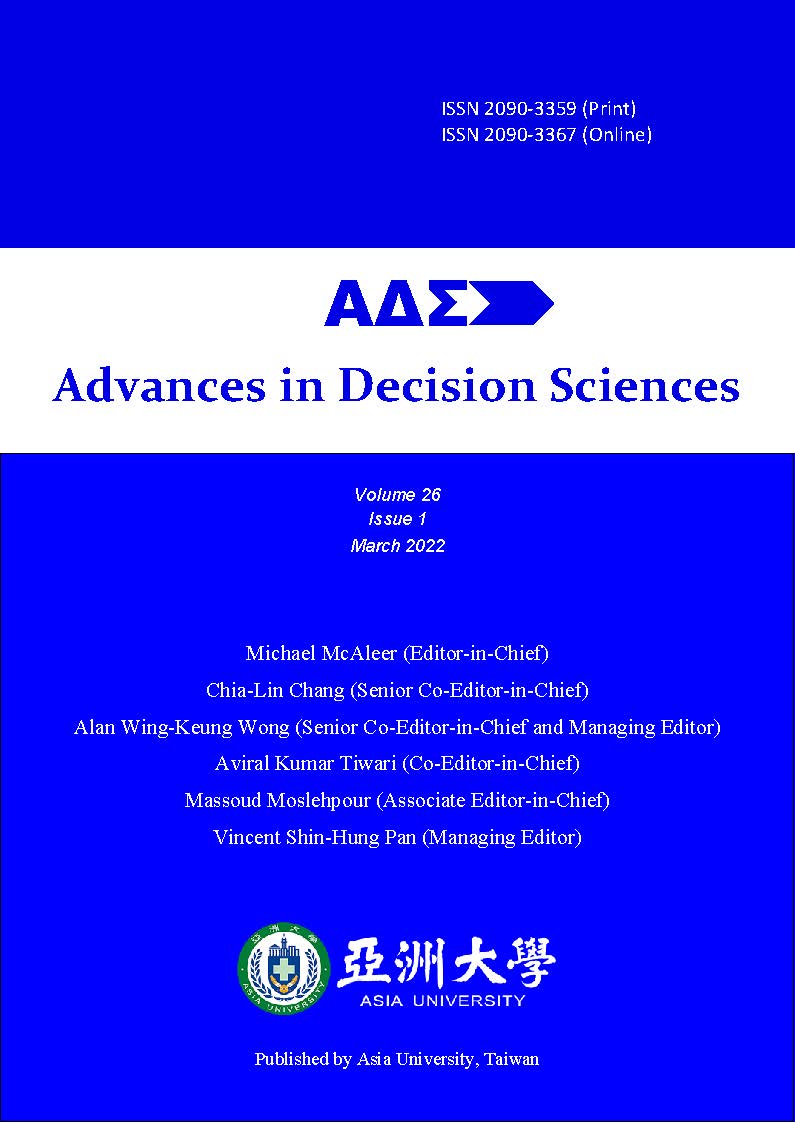Forecasting the Impact of COVID-19 Epidemic on China Exports using Different Models
DOI:
https://doi.org/10.47654/v26y2022i1p102-127Abstract
Purpose: The primary objective of this paper is to identify the best forecasting model for China exports, especially during the spread of the COVID-19 pandemic.
Methodology: We used the data of China exports to the United States and different economic regions from January 2014 to January 2021 to compare models using various criteria and selected the best exports forecast model. The hybrid model is employed to conduct the analysis. The combination of the hybrid model consists of six different models: ARIMA, ETS, Theta, NNAR, seasonal and trend decomposition, and TBATS model.
Findings: Our results showed that the hybrid and ANN outperformed the remaining models in forecasting China exports to the world, considering the shock created by the ongoing coronavirus pandemic. This paper underscores the importance of using the specified models in forecasting exports during this period. The results also demonstrate that the magnitude of China exports to all groups decreased and will continue to decline for the next few months.
Practical Implication: Forecasting of the export data is presented for the subsequent nine months, thereby providing insights to all policymakers, governments, and investors to be proactive in designing their strategies to avoid any delay/disruption in the imports from China, which could enhance the smooth flow of raw material and sustain industrial production.
Keywords: COVID-19, Exports, Forecasting, Artificial neural network, Hybrid, Models.
References
Alam, T. (2019). Forecasting exports and imports through artificial neural network and autoregressive integrated moving average. Decision Science Letters, 8(3), 249-260.
Al-Othman, W. B., Lababidi, H. M., Alatiqi, I. M., & Al-Shayji, K. (2008). Supply chain optimization of petroleum organization under uncertainty in market demands and prices. European Journal of Operational Research, 189(3), 822-840.
Al-Qaness, M. A., Ewees, A. A., Fan, H., & Abd El Aziz, M. (2020). Optimization method for forecasting confirmed cases of COVID-19 in China. Journal of Clinical Medicine, 9(3), 674.
Amankwah-Amoah, J. (2020). Stepping up and stepping out of COVID-19: New challenges for environmental sustainability policies in the global airline industry. Journal of Cleaner Production, 271, 123000.
Anastassopoulou, C., Russo, L., Tsakris, A., & Siettos, C. (2020). Data-based analysis, modelling and forecasting of the COVID-19 outbreak. PloS one, 15(3), e0230405.
Ardabili, S. F., Mosavi, A., Ghamisi, P., Ferdinand, F., Varkonyi-Koczy, A. R., Reuter, U., ... & Atkinson, P. M. (2020). Covid-19 outbreak prediction with machine learning. Algorithms, 13(10), 249.
Arezki, R., & Brueckner, M. (2014). Effects of international food price shocks on political institutions in low-income countries: evidence from an international food net-export price index. World Development, 61, 142-153.
Australian Government. (2020). G20. https://www.dfat.gov.au/trade/organisations/g20/Pages/g20, accessed on May. 2020.
Beenish SULTAN (2016) China’ s Role in BRICS & Relevance to GCC-China
Relations: Complementarities & Conflicting Interests, Journal of Middle Eastern and Islamic Studies (in Asia), 10:2, 71-98, DOI: 10.1080/19370679.2016.12023283.
Boot, A. W., Carletti, E., Haselmann, R., Kotz, H. H., Krahnen, J. P., Pelizzon, L., ... & Subrahmanyam, M. G. (2020). The coronavirus and financial stability (No. 78). SAFE Policy Letter
Box, G. E., Jenkins, G. M., Reinsel, G. C., & Ljung, G. M. (2015). Time series analysis: forecasting and control. 2015.
Chakraborty, T., & Ghosh, I. (2020). Real-time forecasts and risk assessment of novel coronavirus (COVID-19) cases: A data-driven analysis. Chaos, Solitons & Fractals, 135, 109850.
China-EU Statistics. (2021). China-EU - international trade in goods statistics. https://ec.europa.eu/eurostat/statistics-explained/index.php/China-EU_-_international_trade_in_goods_statistics, accessed on April, 2021.
Cirillo, P., & Taleb, N. N. (2020). Tail risk of contagious diseases. Nature Physics, 16(6), 606-613.
de Vet, J. M., Nigohosyan, D., Ferrer, J. N., Gross, A. K., Kuehl, S., & Flickenschild, M. (2021). Impacts of the COVID-19 pandemic on EU industries. European Parliament.
Diamantopoulos, A., & Winklhofer, H. (2003). Export sales forecasting by UK firms: Technique utilization and impact on forecast accuracy. Journal of Business Research, 56(1), 45-54.
Djalante, R., Nurhidayah, L., Van Minh, H., Phuong, N. T. N., Mahendradhata, Y., Trias, A., ... & Miller, M. A. (2020). COVID-19 and ASEAN responses: Comparative policy analysis. Progress in Disaster Science, 8, 100129.
Diamantopoulos, A., & Winklhofer, H. (1999). The impact of firm and export characteristics on the accuracy of export sales forecasts: evidence from UK exporters. International Journal of Forecasting, 15(1), 67-81.
Economic Bulletin, (2015). Quarterly report on the Spanish economy. https://www.bde.es/f/webbde/SES/Secciones/Publicaciones/InformesBoletinesRevistas/BoletinEconomico/15/Mar/Files/be1503e.pdf. Accessed on Feb. 2020.
Euro Zone Fast Facts (2020), Retrieved from https://edition.cnn.com/2013/07/09/world/europe/eurozone-fast-facts/index.html, accessed on 10 July, 2020.
Fahrholz, C., & Wójcik, C. (2013). The Eurozone needs exit rules. Journal of Banking & Finance, 37(11), 4665-4674
Fernandes, N. (2020). Economic effects of coronavirus outbreak (COVID-19) on the world economy. Available at SSRN 3557504..
Fugazza, M. (2020). Impact of the COVID-19 Pandemic on Commodities Exports to China: UNCTAD Research Paper No. 44.
Goodell, J. W. (2020). COVID-19 and finance: Agendas for future research. Finance Research Letters, 35, 101512.
Goolsbee, A., & Syverson, C. (2021). Fear, lockdown, and diversion: Comparing drivers of pandemic economic decline 2020. Journal of Public Economics, 193, 104311.
Gopinath, G. 2020a. The Great Lockdown: Worst Economic Downturn Since the Great Depression. IMFBlog, Retrieved from https://blogs.imf.org/2020/04/14/the-great-lockdown-worst-economic-downturn-since-the-great-depression/. accessed on 15 April, 2020.
Gopinath, G. 2020b. Reopening from the Great Lockdown: Uneven and Uncertain Recovery. IMFBlog, Retrieved from https://blogs.imf.org/2020/06/24/reopening-from-the-great-lockdown-uneven-and-uncertain-recovery/, accessed on 25 June, 2020
Gros, D. (2021). The US–China technology conflict: The causes. In The China–US Trade War and South Asian Economies (pp. 217-228). Routledge.
Gunay, S., Can, G., & Ocak, M. (2020). Forecast of China's economic growth during the COVID-19 pandemic: a MIDAS regression analysis. Journal of Chinese Economic and Foreign Trade Studies.
Hanslin Grossmann, S., & Scheufele, R. (2019). PMIs: Reliable indicators for exports? Review of International Economics, 27(2), 711-734.
Hayakawa, K., & Mukunoki, H. (2020). Impacts of covid-19 on international trade: evidence from the first quarter of 2020 (No. 791). Institute of Developing Economies, Japan External Trade Organization (JETRO).
Hyndman, R. J., & Koehler, A. B. (2006). Another look at measures of forecast accuracy. International journal of forecasting, 22(4), 679-688
Hyndman, R. J., Akram, M., & Archibald, B. C. (2008). The admissible parameter space for exponential smoothing models. Annals of the Institute of Statistical Mathematics, 60(2), 407-426.
Hyndman, R. J. (2004). The interaction between trend and seasonality. International Journal of Forecasting, 20(4), 561-563.
ITD (International Trade Centre) (2017). BRICS countries: Emerging players in global services trade. ITC, Geneva
Jiangli, Su. (2020), European & American Think Tanks and the Reality of US China Trade War: An NPF Application. In: Journal of Social and Political Sciences, Vol.3, No.2, 375-388.
Jones, B. F., & Olken, B. A. (2010). Climate shocks and exports. American Economic Review, 100(2), 454-59
Jordà, O., Singh, S. R., and Taylor, A. M. 2020. The Long Economic Hangover of PANDEMICS. Finance & development., VOL. 57, NUMBER 2.
Kumar, S., Viral, R., Deep, V., Sharma, P., Kumar, M., Mahmud, M., & Stephan, T. (2021). Forecasting major impacts of COVID-19 pandemic on country-driven sectors: challenges, lessons, and future roadmap. Personal and Ubiquitous Computing, 1-24.
Majaski, C. (2020), Brazil, Russia, India, and China (BRIC) reprt, retrived from https://www.investopedia.com/terms/b/bric.asp. accessed on 5 June, 2020.
Moslehpour, M., Al-Fadly, A., Ehsanullah, S. et al. Assessing Financial Risk Spillover and Panic Impact of Covid-19 on European and Vietnam Stock market. Environ Sci Pollut Res (2022). https://doi.org/10.1007/s11356-021-18170-2
OECD stat, 2020, Retrieved from https://stats.oecd.org/Index.aspx?DataSetCode=QITS, accessed on 15/07/2020,
Ozili, P. K., & Arun, T. (2020). Spillover of COVID-19: impact on the Global Economy. Available at SSRN 3562570.
Parteka, A. (2020). What drives cross-country differences in export variety? A bilateral panel approach. Economic modelling, 92, 48-56.
Perrella, A., Carannante, N., Berretta, M., Rinaldi, M., Maturo, N., & Rinaldi, L. (2020). Editorial–Novel Coronavirus 2019 (Sars-CoV2): a global emergency that needs new approaches. Eur Rev Med Pharmaco, 24, 2162-2164.
Petropoulos, F., & Makridakis, S. (2020). Forecasting the novel coronavirus COVID-19. PloS one, 15(3), e0231236.
Pierre Haren and David Simchi-Levi (2020), retrieved from https://hbr.org/2020/02/how-coronavirus-could-impact-the-global-supply-chain-by-mid-march, accessed on 5 June, 2020.
Cirillo, P., & Taleb, N. N. (2020). Tail risk of contagious diseases. Nature Physics, 16(6), 606-613.
Safi, S. K., & Sanusi, O. I. (2021). A hybrid of artificial neural network, exponential smoothing, and
ARIMA models for COVID-19 time series forecasting. Model Assisted Statistics and Applications, 16(1), 25-35.
UNCTAD report, 2020, retrieved https://unctad.org/en/pages/PublicationWebflyer.aspx?publicationid=2769, accessed on 10 July, 2020
Urrutia, Jackie D., Alsafat M. Abdul, and Jacky Boy E. Atienza. "Forecasting Philippines imports and exports using Bayesian artificial neural network and autoregressive integrated moving average." AIP Conference Proceedings. Vol. 2192. No. 1. AIP Publishing LLC, 2019.
White, A., & Safi, S. K. (2016). The efficiency of artificial neural networks for forecasting in the presence of autocorrelated disturbances. The efficiency of artificial neural networks for forecasting in the presence of autocorrelated disturbances, 5(2).
Williamson, R. B. (1975). Predictive power of the export base theory. Growth and Change, 6(1), 3-10.
Winklhofer, H., Diamantopoulos, A., & Witt, S. F. (1996). Forecasting practice: A review of the empirical literature and an agenda for future research. International Journal of forecasting, 12(2), 193-221.

Published
Issue
Section
License
Copyright (c) 2021 Advances in Decision Sciences

This work is licensed under a Creative Commons Attribution-NonCommercial 4.0 International License.







 Scientific and Business World
Scientific and Business World